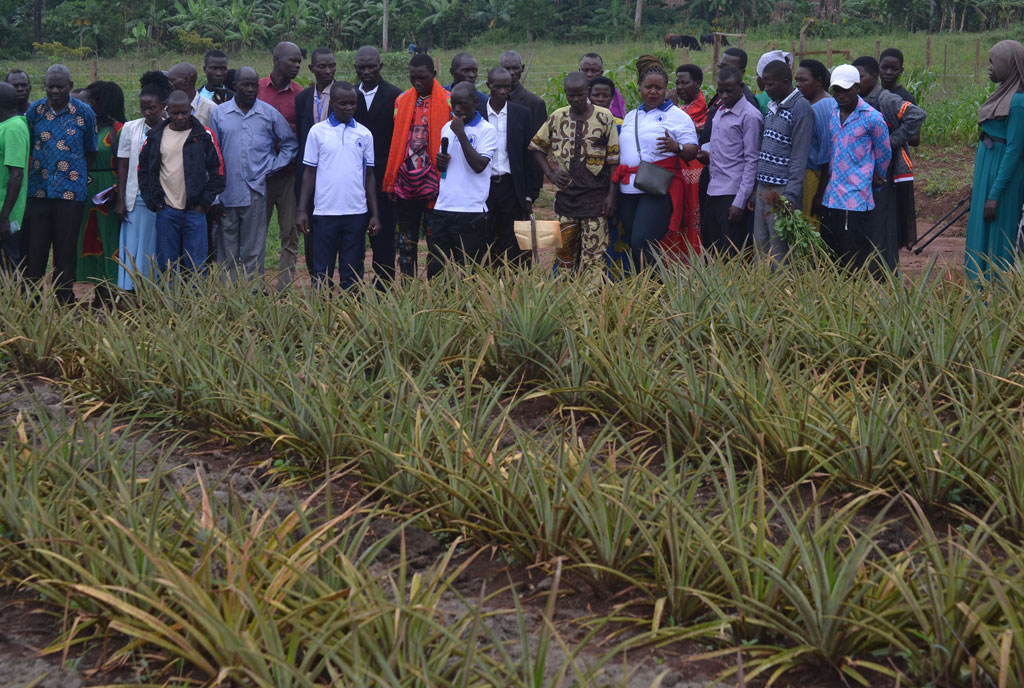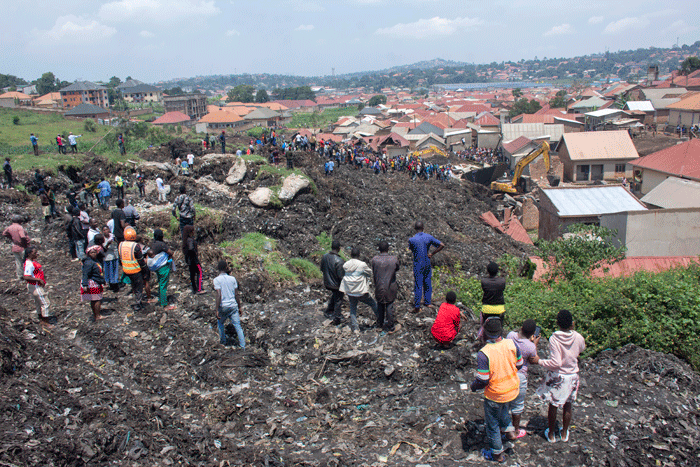Prime
Farmers get skills at Agribusiness Fair

Agronomists at Youth Association for Rural Development (YARD) explain the best practices of growing pineapples during a training. Photo/File
What you need to know:
- At the Naro stall, Adrian Ddumba who is in charge of livestock development at Kamenyamiggo MUZARDI explained to show goers what he referred to as climate smart improved forages. There was a variety of fodder grass on display and their seeds for interested farmers to purchase.
There was a lot to learn for farmers at the six-day-long CBS Pewosa Agribusiness Fair 2023 that was concluded on Monday, this week in Masaka City.
The fair attracted thousands of visitors including farmers, school children, traders, service providers, NGOs, government authorities and organisations.
Agribusiness
It was an opportunity for various agribusiness entrepreneurs and organisations to showcase what they have to offer to farmers and other show goers. It was also an opportunity for learning, discovering, and comparing notes.
Lessons
One of the most visited stalls was staged by National Agricultural Research Organisation (Naro), where visitors learned about the importance of soil testing, good seed selection, fodder grass production, fish farming, urban farming skills, and a whole range of other farming activities.
Eseri Nankya, a soil scientist from Mukono Zonal Agricultural Research Development Institute (MUZARDI) Kamenyamiggo Satellite, was there to demonstrate the importance of farmers getting their farm soil tested to ascertain its state before deciding what fertilisers they need to apply to enhance crop production.
“The farmer must know what is missing in the soil before determining what fertilisers to use,” she said. “Otherwise to apply fertilisers blindly can poison the soil and make it less suitable for crop production. It is also wastage of fertilisers as some farmers actually apply too much some of which is taken by runoff water to aqua systems in the valleys, leading to what is known as eutrophication.”
Nankya went on to disclose that fertilisers that find their way into swamps are often responsible for the extra growth vigour of some wild wetland plants that suffocate fish and other organisms in the aqua system.
Soil testing kits
Nankya said there is a soil laboratory at Kamenyamiggo in Lwengo District. She further disclosed that Kamenyamiggo has a partnership with Holland Greentake Private Soil Labs and JABBA Soil Labs.
“We are still expanding our laboratory at Kamenyamiggo and often we have to refer farmers in Masaka Region to those partners to have their soil samples tested since it would be rather uneconomical for them to travel to Kawanda Agricultural Research Institute to get the service,” she elaborated.
She also educated farmers on several ways of soil conservation technologies that were also well displayed on a chart at the stall.
They included mulching, which protects the soil against water evaporation, soil erosion, weed growth, and regulates soil temperatures besides adding organic matter to the soil. She further explained to the farmers the importance of trash lines across the field, made by establishing contour lines and laying crop residues there.
She said trash lines are suitable for farmers working on gentle slopes because the trash lines trap eroded soil. Another soil conservation method she mentioned was hedgerows which are made by planting shrubs or trees such as Flemmingia and Calliandra to guard against wind soil erosion and to tighten their hold over soil by the roots acting like nails to keep the soil in place apart from adding organic matter to the soil.
Soil protection
Nankya said Grass strip/bund is another way of soil protection. “These are planted along the contour with fodder grass such as napier and bracharia.
Yet the farmer may let natural grass grow over the contours. They increase ground grass cover, control soil erosion, improve soil structure and enhance water infiltration. They are effective on soils that absorb water quickly and on slopes as steep as 30 percent.”
She further mentioned digging infiltration pits. She said these collect rain water in a garden for easy entrance into the soil. It is suitable for shallow soils and soil with low water absorption capacity.
Nankya advised farmers to construct stone lines or bunds which tend to slow down running water and enhance soil water retention as well as control soil erosion. She also encouraged farmers to dig Zai pits or Permanent Planting Basins.
“These pits capture rain and surface water, reactivate biological activities in the soil and cause an improvement in soil structure,”said Nankya. She advised farmers to dig infiltration trenches as another way to control soil erosion and to trap runoff water for easier absorption into the soil.
Soil testing
One of the most visited stalls was staged by National Agricultural Research Organisation (Naro), where visitors learned about the importance of soil testing, good seed selection, fodder grass production, fish farming, urban farming skills, and a whole range of other farming activities.
Livestock forage
Adrian Ddumba who is in charge of livestock development at MUZARDI explained to farmers what he referred to as climate smart improved forages.
There was a variety of fodder grass on display and their seeds for interested farmers to purchase.
Ddumba pointed out that three of the hybrid grass varieties, bracharia toledo, bracharia mulato, and bracharia cayman are most recommended because of several reasons.
He said they have improved tolerance to drought, they grow fast, and they have good yields as high as 10-40 tonnes of forage per hectare and 100-140 kilogrammes of seed per hectare. He said the fodder grass varieties have good storage quality and fast recovery after harvest or livestock grazing over it. He said the grass varieties can be cut and utilised as livestock feed some 60-70 days (8-10) after planting. The grass varieties can be fed to livestock when still green or conserved as hay or silage.
Ddumba also displayed improved elephant grass types: sugar napier and sugarcane and super napier (Packong), and millet as another set of climate smart improved forages. He said the fodder grasses give a yield of 20-30 tonnes per hectare per year.
He further said the grasses make good silage when harvested at around six months. They are used to control soil erosion when planted across gardens on the slope. He also said they can be a lucrative business for people who grow them and sell them as feed to livestock keepers.
Fauzia Tusabe, operation officer Naro Holdings Ltd, which is a private arm of Naro that promotes and markets seeds displayed Longe 5 maize variety. She said Longe 5 maize which is often referred to as orange or yellow maize is the best for low income farmers because its seed can be saved by the farmer for planting in the next two or three planting seasons.
She disclosed that Naro has improved seeds for rice, sorghum, soybean, cowpea, sweet potato vines, cloned coffee seedlings, Hass avocado, banana suckers, simsim, and sunflower among others.
There was a display of vegetable production in plastic containers as a demonstration that people in urban areas can produce their own vegetables.




